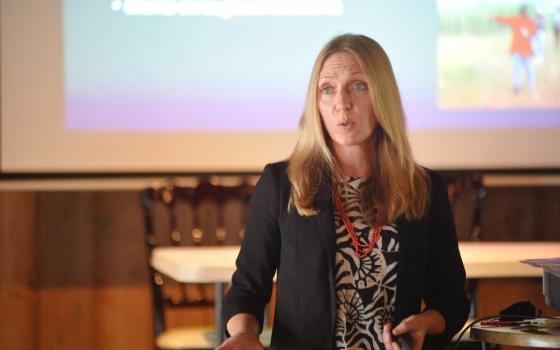
Cenacle Sr. Marlen Java talked to catechists and educators about "Faces of the Family: The Overseas Filipino Workers Challenge" in Paco Catholic School on May 13, the start of the Asian Conference on the Family. (N.J. Viehland)
Parish volunteer Mar Baustista regularly browses through Facebook to maintain contact with members of his “transnational family.”
Bautista and his wife live in Kidapawan, southern Philippines, where they run marriage encounters in their parish. Their daughter is based in London where she takes care of elderly people, and their younger son works in Abu Dhabi; two other Bautista children live in the Philippines.
Bautista told people at a session of the Asian Conference on the Family that through the online social networking service, he can “visit” with his son stationed in the capital of the United Arab Emirates.
The Bautista couple was among some 1,000 delegates who joined sessions on the Catholic church’s Charter of Rights of the Family on May 13 tailored for catechists and educators.
Religious of the Cenacle Sr. Malen Java, who led the afternoon session, discussed the plight of families like Bautista's whose members are scattered in different countries because that is where they can find temporary work.
Java presented on the topic “Faces of the Family: The Overseas Filipino Workers Challenge” on the first day of the four-day conference organized by the Catholic Bishops’ Conference of the Philippines. Aside from catechists, it gathered 551 delegates from 14 Asian countries.
Bautista told that session at Paco Catholic School about the time he saw a picture of his son on Facebook sitting alone in the park. “I felt so sad,” Bautista said, because he knew his son was dealing with a problem with his visa. The father was moved to post the comment, “I like seeing you. You look like you're reflecting.” He said he just wanted to give his son a boost.
With his daughter, Bautista uses the cell phone so she can “talk to me about problems with her husband. I listen to them. I don’t scold. After crying she would say, ‘Thank you dad. I’m happy now.’ When she tells me about achievements, I praise her,” Bautista said. He also shares Filipino recipes and prayers with his children.
OFW phenomenon
Java in her presentation traced the “tremendous growth’ in number of Filipino overseas workers over the past 40 years reaching an estimated 12 million workers, or 12 percent of the country’s population by 2012.
Seventy percent of the workers are between 25 and 44 years old, and among those under 40, most are women.
Lack of jobs in the Philippines will continue to motivate the Filipinos, especially the youth, to try foreign labor markets in years to come, Java predicted.
Since 1992, growing demand for care workers in East and Southeast Asia has meant that women make up 55 percent to 60 percent of the annual outflow of labor from the Philippines.
There are more seafarers, too, up 75 percent in 10 years, with a market share of 25 percent to 30 percent being Filipino, and a large part of those being women working on passenger vessels. This so-called feminization of migration affects families in a direct way.
Transnational parenting
Behavior of families like the Bautistas’ has caught the attention of social scientists and people researching into the lives and family of migrant workers, Java noted. Much of the literature focuses on the role of technology in long-distance mothering rather than fathering.
Asian married migrant women who leave children behind with their husbands and/or relatives have been using the Internet, mobile phones, tablets and apps like Skype and Viber to keep family relationships alive.
Married migrant mothers make sure their weekly schedule includes regular communication with left-behind families, and cell phones are the most popular means to do so.
“Transnational mothers often described as ‘supermoms’ by their children not only reconstitute mothering by providing acts of care from afar but also by over-compensating for their physical absence,” Java told delegates.
“Some migrant domestic workers in Hong Kong are called cell phone mothers because they literally help their children do their homework through the cell phone,” she reported. Some mothers also text their children Biblical messages every morning.
While this kind of concern-in-absence makes distant motherhood possible and helps to alleviate the pain of separation for the migrant worker, Java points out that it also means mothers bear the triple burden of work, family care and sending home money to the family.
“This is in sharp contrast to migrant fathers who tend to reduce their relationship with children to monthly remittances,” she added.
Challenges
Surveys show almost half of the country's young population has neither one nor both parents around. With absent parents and widespread access to technology, youth are coming to regard the media as an authority on what is right, wrong and important, Java said, citing the McCann Erickson 2006 Youth Study and a 2000 study of youth and media
The technocentric life is the context of today's youth. However, living in a cyberworld or vitual reality leaves some confused and perplexed with the complexities of globalized society, Java said. This reflects what is interpreted as the youth's plummeting value systems, according to the study.
Former Philippine Psychiatric Association president Dr. Felicitas Soriano had said that while there is no official study on behavioral effects of migration on children, their clinical experience shows OFW children having emotional problems.
Psychiatrists have worked with some OFW children who have become materialistic and spend their parents' money on gadgets and Internet gaming because of lack of parental guidance.
Dr. Grace Macapagal, the in-house psychiatrist for Crisis Intervention Rehabilitation in the Department of Social Welfare and Development added that there were instances when the eldest daughter became the substitute for the mother. She said that sometimes, it is the eldest daughter who also takes up the sexual role of the mother for some fathers.
International labor migration, especially of mothers, has revived the importance of the extended family and the shift of childcare from parents to them, Java said.
Traditional notions of masculinity and femininity and appropriate gender roles call for review. People ministering to migrant worker families are also called to help them maximize benefits and tackle difficulties created for left-behind spouses and children
Java said, “Transnational family life within the reality of feminization of migration challenges our current understanding and discussions that put gender relations only within the context of the household and families and ignores how state and church policies and programs influence family-level gender and power relations.”
Helping by listening
Java, who holds a masters’ degree in education and in theological studies has been a Cenacle Sister for 33 years. She has directed retreats and served as spiritual director to religious in all levels of formation.
The former Cenacle regional superior and regional council member directs novices for Philippines-Singapore Cenacle.
At the conference she advised a catechist, who asked how he could help troubled or “dysfunctional” students from transnational families, to devote much time and effort to listening.
“Listen to their stories. Don’t preach to them immediately, because no one listens to their heartaches…loneliness…dysfunction.”
She said it is what she does with her nieces and nephews – the children of her OFW brother.
[N.J. Viehland is an NCR correspondent based in the Philippines.]



